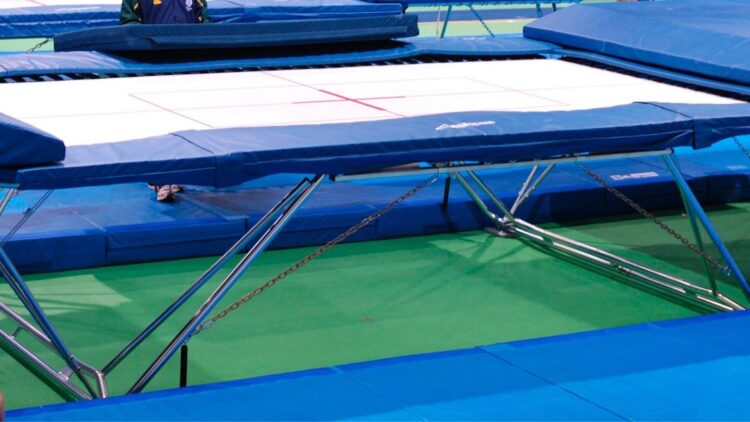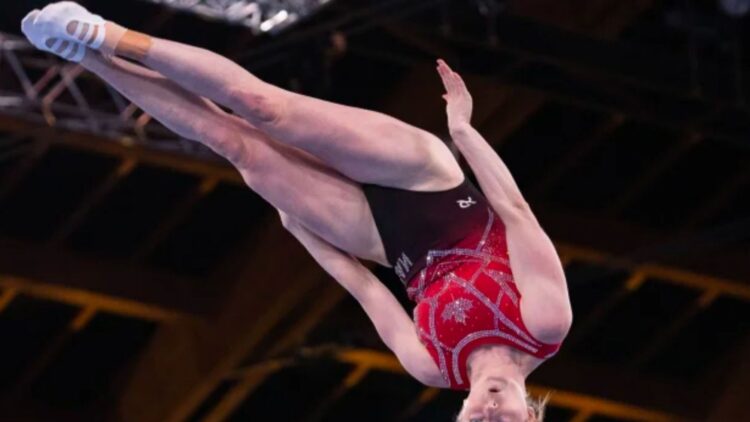
OBJECTIVE OF TRAMPOLINE: Score more points than all other competitors by completing successive mid-air stunts.
NUMBER OF PLAYERS: 1+ player(s)
MATERIALS: Uniform
TYPE OF GAME: Sport
AUDIENCE: 6+
OVERVIEW OF TRAMPOLINE
Trampoline is a gymnastics discipline that takes many peoples’ favorite childhood activity of bouncing around on a trampoline and turns it into a highly competitive event. Unlike backyard trampolines, however, Olympic trampolines are far more elastic and have springs with much higher tension. In turn, this results in Olympic gymnasts being able to jump a full 33 feet in the air!
Most people know the trampoline as a recreational activity enjoyed by kids. However, the first-ever trampoline built at the University of Iowa in 1934 was actually developed by a young man named George Nissen specifically for gymnasts to practice their in-air acrobatics.
Nissen originally got the inspiration to construct a trampoline at the age of 16 when he observed circus performers jumping off high platforms, performing tricks, and landing in a safety net. Nissen imagined a device that would allow the performers to keep bouncing and continue their tricks, an idea that led him to deconstruct his bed to create prototypes. In due time, trampolines were used to train athletes of all acrobatic sports: divers, tumblers, freestyle skiers, and even pilots and astronauts!
The popularity of trampolines as a recreational activity began almost immediately after their invention when Nissen took one to his local YMCA. After bouncing for a few minutes, the kids enjoyed it so much that they refused to go swimming because they’d rather play on the trampoline!
In 1962, the trampoline was officially recognized as a sport by the International Gymnastics Federation. George Nissen was part of the American team that took home the title at the sport’s inaugural international competition in Great Britain. Less than 40 years later, in 2000, the trampoline would make its Olympic debut as a gymnastics discipline, with Nissen being there to witness and even test the trampolines himself.
SETUP
EQUIPMENT
Similar to other gymnastics events, trampoline gymnasts require no equipment other than a uniform and, of course, a trampoline. These uniforms are the same ones other gymnasts use: women wear leotards, while men wear sleeveless shirts and pants.
OLYMPIC TRAMPOLINES

The trampolines used for Olympic/competitive trampoline events are quite different from those a person may have in their backyard. The main difference is the amount of tension in the springs of an Olympic trampoline. This increased spring tension, combined with the high-quality elastic and porous trampoline bed, allows gymnasts to jump much higher with less effort.
In general, an Olympic trampoline allows a gymnast to reach more than 30 feet in bounce height and comfortably complete at least three rotations in the air. Because of how dangerous a bad fall can become from this elevation, every trampoline has a giant red ‘X’ in the exact middle of the trampoline. This allows gymnasts to know where on the trampoline they’re about to land. Additionally, an athlete’s ability to land close to this center marking is a part of some competitions’ scoring criteria (horizontal displacement).
Check out just how high these Olympic athletes can jump!
Women’s Trampoline Individual Final | Rio 2016 Replay
EVENTS
Trampoline consists of four different events:
- Individual: The sport’s main attraction, individual trampoline events consist of a single gymnast performing a routine that combines ten required elements.
- Synchronized: Two athletes perform a synchronized routine while on two separate trampolines.
- Double Mini-Trampoline: This event is very similar to a typical gymnastics vault event, as a gymnast begins with a sprint, jumps off an angled trampoline, performs another jump after landing on a flat trampoline, and then sticks the dismount landing on the ground.
- Tumbling: This event somewhat resembles a gymnast’s floor routine, as they essentially perform many stunts in succession along an 80-foot-long track. Unlike the other trampoline events, the track used in this event resembles a springboard more than a trampoline.
Despite having four different events, the Olympic Games have only ever featured men’s and women’s individual events.
GAMEPLAY

SCORING
Like other gymnastics events, trampoline gymnasts are judged on the difficulty and execution of their routine. However, due to the nature of the trampoline, competitors are also judged depending on their time of flight (which is kept track of electronically) and horizontal displacement (how close to the center of the trampoline they land).
A gymnast’s difficulty score always begins at zero points. After each of the ten elements is performed, judges will refer to a scoring card to determine how many points each one is worth. There is no limit to how many difficult points a routine can be worth.
A competitor’s execution score always begins at a perfect ten points. Then, a panel of five judges (this number depends on the event/competition) deducts up to 0.5 points for each mistake made during the execution of an element. The gymnast’s final execution score excludes the highest and lowest judge scores and combines the three middle scores. This means a perfect execution score would be 30 points (three perfect 10.0 scores).
The time of flight score is somewhat new to trampoline gymnastics and isn’t featured in every competition, although it was used at the 2020 Tokyo Olympics. Kept track of by an automated electronic system, the total time spent by a gymnast in the air during their routine (in seconds) is added to their final score.
The horizontal displacement scoredescribes how close to the center of the trampoline a gymnast’s bounces are. Not only is this a matter of accuracy and body control, but bouncing in the center of the trampoline is also a matter of safety. Not every event uses a horizontal displacement score; sometimes, it is just factored into the execution score.
1) Individual Scoring
Individual trampoline events consist of a single gymnast performing ten total jumps/elements. These ten elements are then scored based on three different categories: difficulty score, execution score, and time of flight.
A gymnast’s final score for an individual event is their difficulty score + execution score + seconds spent in flight.
2) Synchronized Scoring
Synchronized trampoline events are scored the same way as individual events, although each gymnast is scored separately (before being averaged together). The pair is then given a synchronization score in relation to how well they mirrored each other’s movements, especially bounce height.
Some competitions choose to include the time of flight as part of the execution score and instead provide an entirely separate scoring category for horizontal displacement.
3) Double Mini-Trampoline Scoring
Double mini-trampoline events are often judged only on difficulty and execution. A significant part of scoring in this event revolves around the gymnast’s dismount and ability to land cleanly.
4) Tumbling Scoring
The single, long, and complex tumble/somersault routines in trampoline tumbling are judged based on difficulty and execution. Judges specifically look for how many flips and twists the gymnast performs, as well as the direction of the body when doing them.
ADDITIONAL RULES/SCORING CRITERIA
- A gymnast must also start and finish a routine on both feet.
- Competitors are allowed a single vertical bounce after finishing their routine to slow their momentum. After this single bounce, the gymnast must use a technique of bending their knees to completely stop their bounce or face possible point deductions.
- After a routine, a gymnast must hold their dismount/finishing stance for three full seconds before moving.
END OF GAME
The gymnast(s) with the highest combined score of their event’s scoring categories is the winner of the event.
- 30 GAMES TO PLAY OVER TEXT - April 22, 2024
- 20+ FREE PRINTABLE BABY SHOWER GAMES - April 16, 2024
- 20+ College Party Games for the Best Night Ever! - April 2, 2024